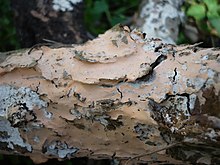Corticiaceae
| Corticiaceae | |
|---|---|

| |
| Erythricium laetum | |
| Scientific classification | |
| Domain: | Eukaryota |
| Kingdom: | Fungi |
| Division: | Basidiomycota |
| Class: | Agaricomycetes |
| Order: | Corticiales |
| Family: | Corticiaceae Herter (1910) |
| Type genus | |
Pers.
| |
| Genera | |
|
Basidiodesertica | |
The Corticiaceae are a
Taxonomy
History
The German
In this wide sense, the boundaries of the Corticiaceae were never clearly defined. It was sometimes separated from the Stereaceae, a family in which fruitbodies had a tendency to form pilei (caps or brackets),[1] but often these two artificial families were united. In this united sense, the Corticiaceae certainly included the genera and species treated in the standard, 8-volume reference work The Corticiaceae of North Europe (1972-1987), where it was acknowledged that the family was "not a natural taxon but an assemblage of species with similar habitat."[2] With the addition of non-European species, this meant that the Corticiaceae eventually expanded to include over 200 genera worldwide.[3] The name "Corticiaceae" is still occasionally used in this wide sense (sensu lato),[4] but it has generally been replaced by the term "corticioid fungi".[5]
Current status
Description
Though now based on
Habitat and distribution
Several species in the Corticiaceae are wood-rotting
Economic importance
A number of species within the Corticiaceae are commercially important
References
- ^ S2CID 82916652.
- ISBN 978-82-90724-03-5.
- ISBN 978-0-85198-885-6. (In which the "Corticiaceae s.l." is approximately equivalent to the "Stereales")
- ISBN 978-88-901057-9-1.
- ^ (e.g.) Hjortstam K, Ryvarden L (2007). "Checklist of corticioid fungi (Basidiomycotina) from the tropics, subtropics and the southern hemisphere". Synopsis Fungorum. 22: 27–146.
- ^ PMID 34512580.
- ^ S2CID 13102957.
- ^ S2CID 23996344.
- PMID 18501576.
- .
- .
- PMID 34380577.
- PMID 30795375.
- ^ "Red Thread lawn disease - cause, symptoms and treatment". www.lawnandmower.com. Retrieved 31 March 2018.
